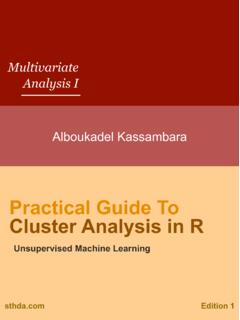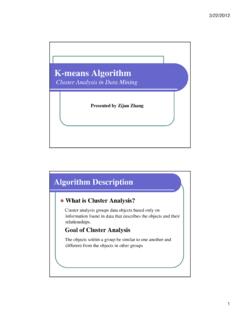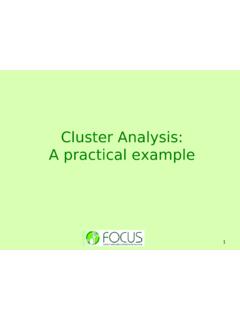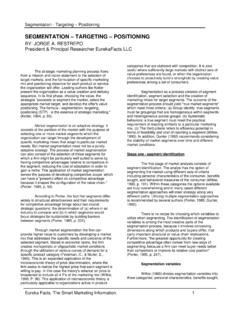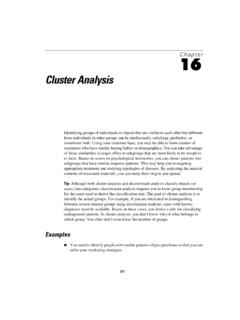Transcription of Market Segmentation - Decision Analyst
1 Copyright 2019 Decision Analyst . All rights or SegmentationWhen the term Market Segmentation is used, most of us immediately think of psychographics, lifestyles, values, behaviors, and multivariate cluster analysis routines. Market Segmentation is a much broader concept, however, and it pervades the practice of business throughout the is Market Segmentation ? At its most basic level, the term Market Segmentation refers to subdividing a Market along some commonality, similarity, or kinship. That is, the members of a Market segment share something in common. The purpose of Segmentation is the concentration of marketing energy and force on the subdivision (or the Market segment) to gain a competitive advantage within the segment. It s analogous to the military principle of concentration of force to overwhelm an enemy.
2 Concentration of marketing energy (or force) is the essence of all marketing strategy, and Market Segmentation is the conceptual tool to help achieve this focus. Before discussing psychographic or lifestyle Segmentation (which is what most of us mean when using the term Segmentation ), let s review other types of Market Segmentation . Our focus is on consumer markets rather than business markets, but most of the following concepts also apply to Segmentation This is perhaps the most common form of Market Segmentation , wherein companies segment the Market by attacking a restricted geographic area. For example, corporations may choose to Market their brands in certain countries, but not in others. A brand could be sold only in one Market , one state, or one The purpose of Segmentation is the concentration of marketing energy and force on the subdivision (or the Market segment) to gain a competitive advantage within the Jerry W.
3 Thomas2 Copyright 2019 Decision Analyst . All rights Analyst : Market Segmentationregion of the United States. Many restaurant chains focus on a limited geographic area to achieve concentration of force. Regional differences in consumer preferences exist, and this often provides a basis for geographic specialization. For example, a company might choose to Market its redeye gravy only in the southeastern Likewise, a picante sauce might concentrate its distribution and advertising in the Southwest. A chainsaw company might only Market its products in areas with forests. Geographic Segmentation can take many forms (urban versus rural, north versus south, seacoasts versus interior, warm areas versus cold, high-humidity areas versus dry areas, high-elevation versus low-elevation areas, and so on).
4 These examples also reveal that geographic Segmentation is sometimes a surrogate for (or a means to) other types of Segmentation Different markets can be reached through different channels of distribution. For example, a company might segment the tick and flea collar Market by selling the product to supermarkets under one brand name, to mass merchandisers under another brand name, to pet stores under another brand name, and to veterinarians under yet another brand name. This type of distributional Segmentation is common, especially among small companies that grant each channel a unique brand to gain distribution within that channel. Other examples of distributional Segmentation would be an upscale line of clothing sold only in expensive department stores, or a luxury hair shampoo sold only through upscale beauty salons.
5 Media Segmentation While not common, media Segmentation is sometimes a possibility. It is based on the fact that different media tend to reach different audiences. If a brand pours all of its budget into one media, it can possibly dominate the segment of the Market that listens to that radio station or reads that magazine. Media Segmentation is most often practiced by companies that have some control over the media and can somehow discourage competitors from using that Segmentation Price Segmentation is common and widely practiced. Variation in household incomes creates an opportunity for segmenting some markets along a price dimension. If personal incomes range from low to high, the reasoning goes, then a company should offer some cheap products, some medium-priced ones, and some expensive ones.
6 This type of price Segmentation is well illustrated 3 Copyright 2019 Decision Analyst . All rights Analyst : Market Segmentationby the range of automotive brands marketed by General Motors, historically. Chevrolet, Pontiac, Oldsmobile, Buick, and Cadillac varied in price (and status) along a clearly defined spectrum to appeal to successively higher income Segmentation Gender, age, income, housing type, and education level are common demographic variables. Some brands are targeted only to women, others only to men. Music streaming services tend to be targeted to the young, while hearing aids are targeted to the elderly. Education levels often define Market segments. For instance, private elementary schools might define their target Market as highly educated households containing women of childbearing age.
7 Demographic Segmentation almost always plays some role in a Segmentation Segmentation Time Segmentation is less common, but can be highly effective. Some stores stay open later than others, or stay open on weekends. Some products are sold only at certain times of the year ( , Christmas cards, fireworks). Chili is marketed more aggressively in the fall, with the onset of cooler weather. Football is played in the fall, basketball in the winter and spring, and baseball in the spring and summer (or at least this used to be the pattern). The Olympics come along every four years. Department stores sometimes schedule midnight promotional events. The time dimension can be an interesting basis for Segmentation . Occasion-Based SegmentationPeople tend to behave differently, and think differently, at different times or occasions.
8 For example, dietary habits and preferences vary by occasion: breakfast is different from dinner; eating out on a Friday night is different from grabbing lunch during the week; Thanksgiving dinner is different from most other dinners. These types of differences can be the basis for4 Copyright 2019 Decision Analyst . All rights Analyst : Market Segmentationsegmenting a Market . If the goal is to develop new product development templates for a restaurant chain, then occasion-based Segmentation might be a good solution. If the goal, however, is to develop the strategic positioning and advertising messages for a new smartphone or a new car, then occasion-based Segmentation would not be applicable. In these cases, the goal is one optimal solution, and the occasions do not matter.
9 Markets can be also segmented by hobbies, by political affiliation, by religion, by special interest groups, by sports team loyalties, by university attended, and by hundreds of other variables. You are only limited by your marketing imagination. Psychographic or Lifestyle SegmentationLastly, we come to psychographic (or lifestyle) Segmentation , based upon multivariate analyses of consumer attitudes, values, behaviors, emotions, perceptions, beliefs, needs, benefits, wishes, and interests. Psychographic Segmentation is a legitimate way to segment a Market , if we can identify the proper Segmentation variables (or lifestyle statements, words, pictures, etc.). Qualitative research techniques (focus groups, depth interviews, ethnography) become invaluable at this stage.
10 Qualitative research provides the insight, the conceptual knowledge, and the consumer s exact language necessary to design the Segmentation questionnaire. Typically, verbatim comments from consumers are used to build batteries of psychographic or lifestyle statements (these two terms are used interchangeably). A large representative sample of consumers (generally, 1,000 or more) are then asked about the degree to which they agree or disagree with each statement. For example, if you were designing a Market Segmentation questionnaire for an airline, you might conduct a series of depth interviews to help design the questionnaire. You probably would include a behavioral section (frequency of flying, how purchase tickets, who travel with, cities flown to, where sit, airlines flown, money spent on airline tickets, etc.)

